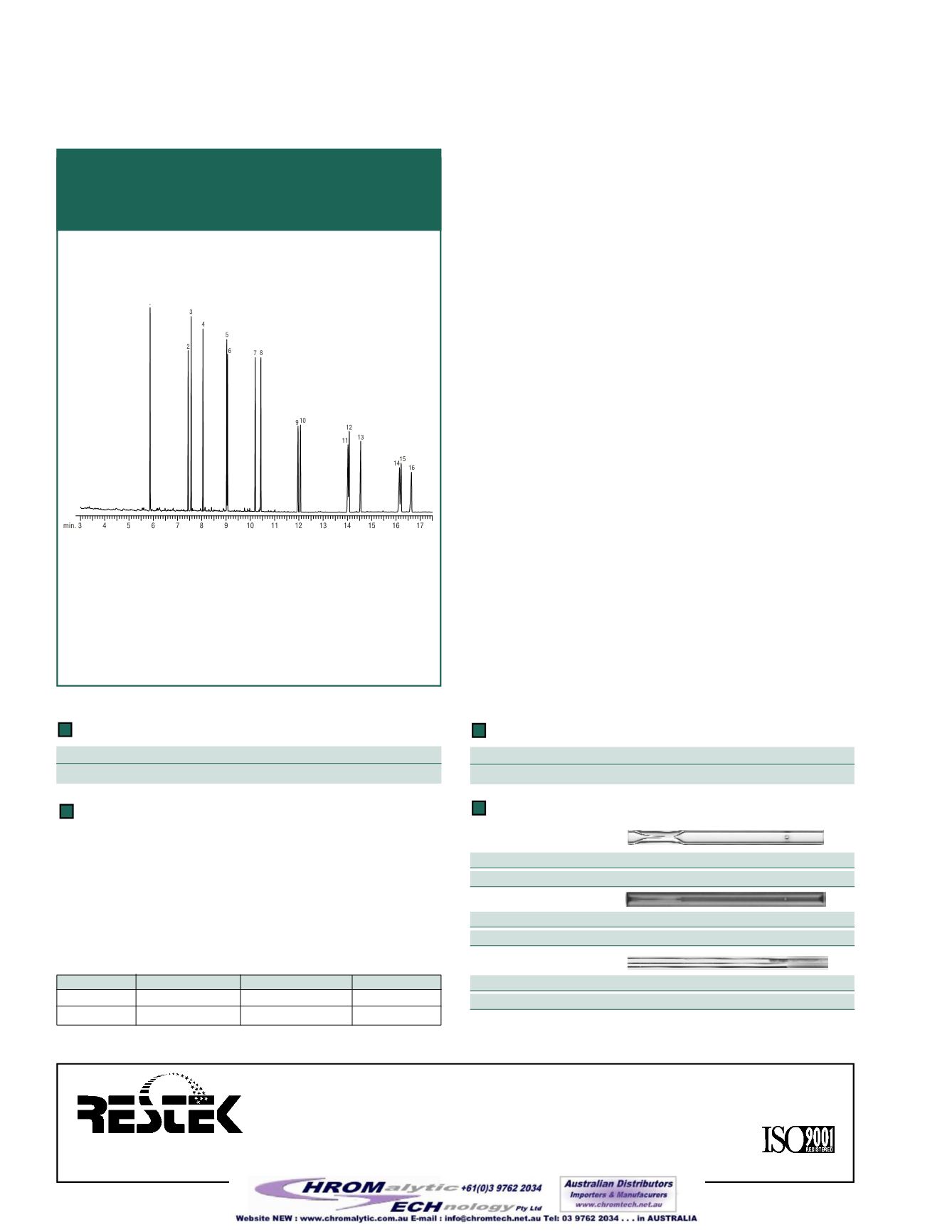
Rtx
®
-5Sil MSColumns
(-60 to 330/350°C)
30m 0.25mmID
0.25µm cat.# 12723
30m 0.32mmID
0.25µm cat.# 12724
Rtx
®
-CLPesticides2Columns
(-60 to 310/330°C)
30m 0.25mmID
0.20µm cat.# 11323
30m 0.32mmID
0.25µm cat.# 11324
Optimizing Temperature Program
Optimizing the temperature programalso contributes to better
resolution of closely eluting peak pairs and shortens analysis
times. The temperature programinFigures 1 and 2 achieves
baseline resolution of indeno(1,2,3-cd)pyrene and
dibenzo(a,h)anthracene, and excellent resolution of
benzo(b)fluoranthene and benzo(k)fluoranthene, while still
keeping the analysis time under 18minutes. Because the col-
umn flow rate and temperature programfor both columns is the
same, the analysis can be run simultaneously on the primary
and confirmation columns.
ReducingDiscrimination
Reduced responseof thehighermolecularweight PAHs is caused
bydiscrimination in the injectionport. Inextreme cases the
responseof the last threePAHcompoundsmaybe lost completely.
Discriminationwill varyby injectionport design.Chromatograms
generatedusingaPerkinElmerAutosysGCsystemexhibitmini-
mal discrimination (Figures 1and2).The area ratioof naphthalene
(peak1) is~2:1compared tobenzo(ghi)perylene (peak16).
Severalmodifications canbemade to reducediscrimination:
increasing injectionport temperature to improvevaporization;
increasing the splitless hold time; andusingadrilledUniliner
®
inlet
sleeve.Thedesignof thedrilledUniliner
®
creates a seal between
the liner and the column,which reduces the loss of highmolecular
weight compounds and thereby improves their response.The
drilledUniliner
®
has a small holedrilledat the topof the liner that
allows it toworkwith small-diameter columns andelectronicpres-
sure control (EPC) injection systems.
Conclusion
PAHanalysis byUSEPAMethod 8100 can be improved by
choosing the appropriate analytical columns and by optimizing
the temperature program, carrier gas type, and column flow
rates.When operating under the conditions listed for Figures 1
and 2, theRtx
®
-5SilMS and theRtx
®
-CLPesticides2 columns
yield excellent resolution and short analysis times for PAHs.
Method 610–PolynuclearAromatic
HydrocarbonsMix
acenaphthene
chrysene
acenaphthylene
dibenzo(a,h)anthracene
anthracene
fluoranthene
benzo(a)anthracene
fluorene
benzo(a)pyrene
indeno(1,2,3-cd)pyrene
benzo(b)fluoranthene
naphthalene
benzo(k)fluoranthene
phenanthrene
benzo(ghi)perylene
pyrene
2,000µg/mL each inCH 2 Cl 2 , 1mL/ampul
Each
5-pk.
10-pk.
31011
31011-510
w/data pack
31011-500
31011-520
31111
Inlet Liners
ForAgilent GCs
DrilledUniliner
®
(4.0mm ID, 6.3mmOD, 78.5mm length)
21054 (ea.)
21055 (5-pk.)
Siltek
™
DrilledUniliner
®
(1.0mm ID, 6.3mmOD, 78.5mm length)
21390-214.1 (ea.)
21391-214.5 (5-pk.)
For PEGCs
AutoSYSSplitlessw/Wool
(2.0mm ID, 6.2mmOD, 92.1mm length)
20829 (ea.)
20830 (5-pk.)
20831 (25-pk.)
©Copyright 2002, RestekCorporation
Figure 2–TheRtx
®
-CLPesticides column is an
excellent confirmational column for polycyclic
aromatic hydrocarbon analysis.
Rtx
®
-CLPesticides2 30m, 0.25mm ID, 0.20µm (cat.# 11323)
Sample:
50µg/mL610 PAHMix standard (cat.# 31011)
in carbon disulfide
Inj.:
1.0µLsplitless (hold 2min.),
2mm splitlessw/ wool inlet liner (cat.# 20829)
Inj. temp.:
330°C
Carrier gas: hydrogen, 4mL/min constant flow
Oven temp.: 40°C (hold 2min.) to 250°C@25°C/min. to 265°C
@5°C/min. to 300°C (hold 4min.)@25°C/min.
Det.:
FID@350°C
1. naphthalene
2. acenaphthylene
3. acenaphthene
4. fluorene
GC_EV00596
5. phenanthrene
6. anthracene
7. fluoranthene
8. pyrene
9. benzo(a)anthracene
10. chrysene
11. benzo(b)fluoranthene
12. benzo(k)fluoranthene
13. benzo(a)pyrene
14. indeno(1,2,3-cd)pyrene
15. dibenzo(a,h)anthracene
16. benzo(ghi)perylene


